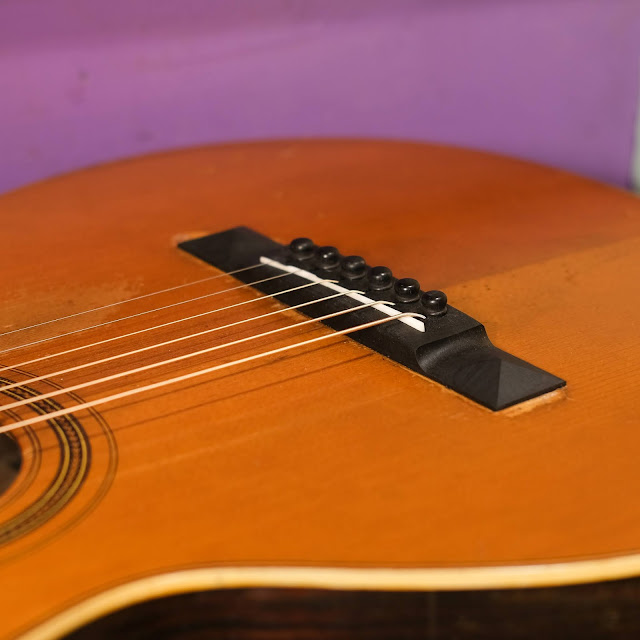1900s Washburn Style 223 0-Size Guitar
This Style 223 is a little bit fancier than most of the same-decade Washburns I come across by way of a few engraved pearl inlays in the bound fretboard and a pretty, herringbone rosette. The neck cut is also a little less extreme (it's a medium-V with a radiused board rather than a big-honking-V) than average and would suit a fingerpicker's paws really well.
I took this in trade-for-work and I'm happy to have done so -- it's a beaut and it has a compelling sound, too. Compared to other, similar-quality makes from the time, this guy has a good amount of lush lower-mids and a clean, full sound for its size. It sounds better fingerpicked than flatpicked but it has a respectable flatpicking tone.
Unlike a lot of period ladder-braced guitars, when you dig-in with a flatpick it doesn't get as much of that compressed/zippy feeling -- the bracing absorbs the energy and kicks it back out "for use" instead, so it responds a little more like an x-braced guitar, curiously. Still, because it's lightly-built, the heaviest strings I suggest are 46w-10 on this. Though technically a classical/gut-strung guitar when it was made, the necks on these have steel reinforcement internally and the bracing is stiff-enough for 10s E-to-E or 11s tuned Eb-to-Eb. Washburns are interesting because some (like this one) sound better with steel while others (like models made just a few years before) sound much better with gut/nylon.
As far as materials -- it's a solid spruce top over solid Brazilian rosewood sides. Yes, the rosewood gives it a creamier, darker sound and a lot more lingering sustain over something this size with mahogany or maple back and sides -- which tend towards more "bark."
Repairs included: a neck reset, fret level/dress, binding reglues, side dots install, removal of damaged old bridge and replacement with a new, pyramid-style ebony one, new bone saddle, new ebony pins, seam repairs, hairline crack repairs, re-repair/minor touch-up to some big cracks on the bass-side at the waist and running to near the endblock, replacement StewMac repro (aged) tuners, cleaning, and setup.
Setup notes: it plays perfectly with 3/32" EA and 1/16" DGBE action at the 12th fret. The neck is straight and while the frets are low and small (like they were when it was made), there's still a decent amount of meat left in them. I reset the neck angle so it'd run with a low-ish saddle (just like on the original-height, damaged original bridge) so there's not a lot of adjustment room, but there is some and it's been stable since stringing. The new slot is drop-in so shim-up height adjustments are quick and painless. String gauges are 46w, 36w, 26w, 18w, 13, 10 extra lights.
Scale length: 24 3/4"
Nut width: 1 7/8"
String spacing at nut: 1 5/8"
String spacing at bridge: 2 3/8"
Body length: 18 1/2"
Lower bout width: 13"
Side depth at endpin: 4 1/8"
Top wood: solid spruce
Back & sides wood: solid Brazilian rosewood
Bracing type: ladder
Fretboard: ebony
Bridge: ebony
Neck feel: medium V-shape, ~12-14" board radius
Neck wood: Spanish cedar or mahogany?
Weight: 3 lb 4 oz
Condition notes: there's a couple long, old crack repairs to the bass-side. They're stable but ugly and were ugly to begin-with. There's also some finish muck-up around the bridge edges due to a sloppy old repair of the original (cracked) bridge. Aside from that there's minor usewear/scratches throughout and a few white-colored small scuffs here and there. It does look nice overall, though, and the back of the neck feels and looks clean and good. The top has aged-in well, too, with a buttery-yellow color and some pickwear at the soundhole. The bridge, saddle, pins, and tuners are all replacements but look "right." There are some filled tiny screwholes at the headstock's sides (from where mismatched tuners had been) and at the endpin area (from where a tailpiece had been added before my time).

























Comments